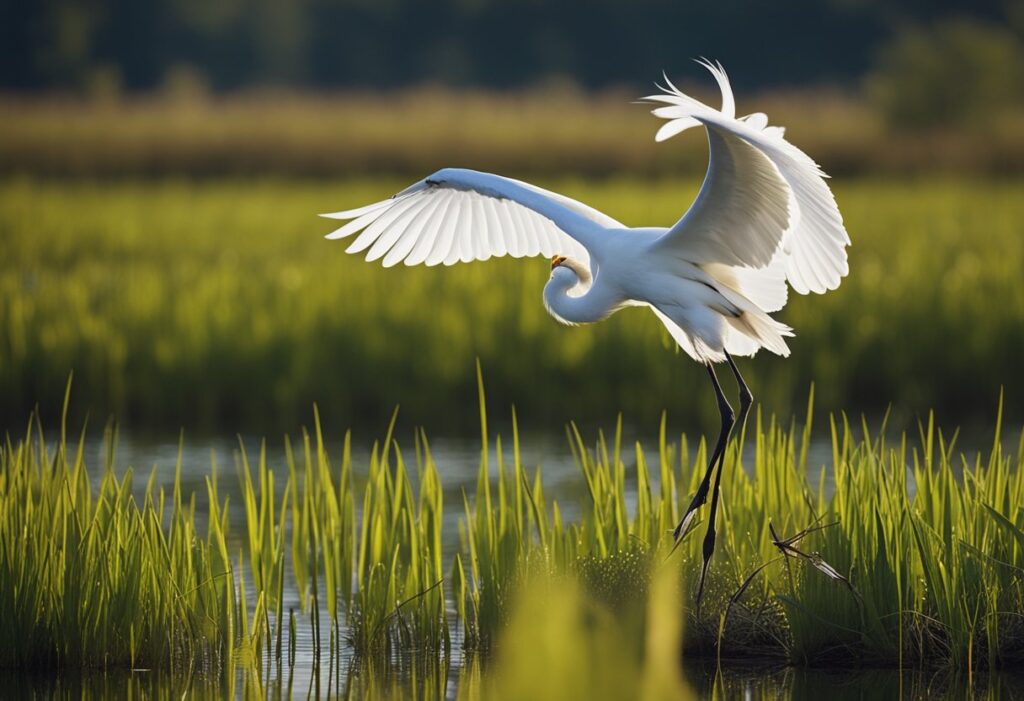Egrets are elegant and graceful birds revered in various cultures for their spiritual symbolism and significance. They are known for their pure white feathers, long necks, and slender legs, which make them a sight to behold.
If you have ever encountered an egret in your dreams or real life, you might be curious about its spiritual meaning and what it represents.
The spiritual meaning of egret varies according to different cultures and belief systems. In some cultures, egrets are seen as messengers of the gods, symbols of purity, and harbingers of good fortune.
In others, they are associated with transformation, adaptability, and connection to the divine. Regardless of the interpretation, the egret is a powerful symbol that can offer guidance, insight, and inspiration to those who seek it.
Key Takeaways
- Egrets are revered in various cultures for their spiritual symbolism and significance.
- The spiritual meaning of egret varies according to different cultures and belief systems.
- Egrets are associated with purity, transformation, adaptability, connection to the divine, and good fortune.
Table of Contents
Egret Symbolism in Various Cultures

Egrets have been revered for centuries in various cultures around the world. Here are a few examples of how these majestic birds have been perceived throughout history:
Ancient Egypt and the God Ra
In ancient Egypt, the egret was associated with the god Ra, often depicted with a bird’s head. The egret was seen as a symbol of purity and grace, and it was believed that Ra would send egrets to guide the souls of the deceased to the afterlife.
Native American Tribes
Native American tribes also held the egret in high regard. The bird was seen as a symbol of peace, and its feathers were used in various ceremonies. In some tribes, the egret was associated with the sun and was believed to bring good luck and prosperity.
Japanese Culture and Symbolism
In Japanese culture, the egret is known as a symbol of purity and elegance. The bird is often depicted in art and literature, and seeing an egret is believed to be a sign of good luck.
In some Japanese myths, the egret is associated with the goddess Amaterasu, the goddess of the sun and the universe.
The egret has played an important role in many cultures throughout history. Whether seen as a symbol of purity, grace, or good luck, this majestic bird inspires awe and admiration today.
Related post: Spiritual Meaning Of White Horse.
Spiritual and Dream Interpretations
If you have seen egrets frequently, you may wonder what spiritual and dream meanings they hold. Egrets are majestic birds that have held a sacred place in the spiritual and dream life of many cultures worldwide.
Here are some interpretations of egrets as omens and in dreams.
Egrets as Omens
In many cultures, egrets are a sign of good luck and prosperity. They are also believed to be messengers of the divine. According to Greek mythology, the egret was Athena’s messenger, the goddess of wisdom.
People would interpret its crackling shriek as an omen that the goddess was watching over someone, sailors in particular. The Maori also have a great reverence for egrets. They call the bird “Kotuku,” meaning “The Great Egret.”
On the other hand, egrets can also be a warning of uncertainty and danger. In some Native American cultures, egrets were seen as a warning of impending danger.
They were believed to be a sign that something bad would happen and that people needed to be cautious.
Dreams Involving Egrets
If you dream about an egret, it could signify spiritual guidance, healing, and renewal. It may also be a desire to reconnect with nature and embrace change. Egrets in dreams can also represent purity, peace, and transformation.
If you dream about an egret flying, it could suggest that you are about to embark on a journey of self-discovery. You may also be on the brink of a new phase in your life.
If the egret stands still in your dream, it could indicate that you must be patient and wait for the right time to act.
In conclusion, egrets hold deep spiritual meaning and symbolism, representing grace, purity, connection to the divine, adaptability, and transformation.
Whether you see them in your waking life or dreams, egrets can offer guidance and insight into your spiritual journey.
Related post: Spiritual Meaning Of House Finch.
Egret as a Totem and Spirit Animal

Understanding the Egret Totem
The Egret totem is a powerful symbol of grace, purity, and spiritual connection. As a totem, the Egret encourages us to embrace our individuality while maintaining a balanced relationship with the world around us.
The Egret totem also represents adaptability and transformation, reminding us to be open to change and trust in life’s journey.
If you find yourself drawn to the Egret totem, it may be a sign that you are ready to embrace your spiritual path and connect with your higher self.
The Egret totem can help you find clarity, peace, and inner strength and guide you through transition and transformation.
The Significance of the Egret Spirit Animal
As a spirit animal, the Egret represents spiritual guidance, healing, and renewal. If you feel a strong connection to the Egret spirit animal, it may be a sign that you are ready to embark on a journey of self-discovery and spiritual growth.
The Egret spirit animal can help you find your inner peace and balance and guide you through times of change and transformation. It can also help you connect with your intuition and inner wisdom, allowing you to make decisions aligned with your highest good.
If you are looking for a powerful spiritual ally, the Egret spirit animal may be just what you need.
Its purity, grace, and adaptability make it a powerful symbol of spiritual growth and transformation, and its presence in your life can help you find the strength and courage to follow your spiritual path.
The Symbolic Attributes of Egrets

Egrets are majestic birds often associated with purity, grace, and wisdom. These birds are known for their beautiful white plumage, symbolizing innocence and cleanliness. This section will explore the symbolic attributes of egrets and what they represent.
Purity and Grace
Egrets embody purity and grace, reflecting their pristine white plumage. Symbolically, they represent a state of innocence and cleanliness. Their presence inspires us to seek purity in our thoughts, actions, and intentions, guiding us toward clarity and righteousness.
They are also associated with grace, the quality of being elegant, dignified, and refined. Egrets teach us to move through life with grace and poise, even in adversity.
Balance and Patience
Egrets are also associated with balance and patience. They teach us to find balance in our lives, to be patient, and to wait for the right time to act. Egrets are known for their skill and patience when hunting for food, a lesson in perseverance and determination.
They remind us to be patient and trust our abilities, even when things seem difficult.
Wisdom and Independence
Egrets are also a symbol of wisdom and independence. They are revered for their intelligence and ability to adapt to their environment. Egrets are self-reliant and independent, teaching us to be confident in our abilities and trust our instincts.
They represent the freedom to be yourself and to live your life on your terms. Egrets remind us to respect ourselves and others and live with dignity and serenity.
In summary, egrets symbolize purity, grace, balance, patience, wisdom, independence, and strength. They are messengers of peace and tranquility, representing harmony and serenity.
Egrets inspire us to seek beauty and light in our lives, to persevere through challenges, and to have the courage to follow our dreams.
Egret Encounters and Their Meanings

Encountering an egret in the wild can be a truly magical experience with deep spiritual significance. Here are some meanings associated with such encounters:
Seeing an Egret in the Wild
If you happen to see an egret in the wild, it could be a sign of good luck and good things to come. This majestic bird is often associated with purity, grace, and innocence.
Its immaculate white plumage serves as a visual representation of untarnished innocence and spiritual cleanliness.
In many cultures, egrets are considered good omens of prosperity and good fortune. So, if you see an egret in the wild, take it as a positive sign and embrace the good things coming your way.
Egret as a Personal Symbol
If you feel a strong connection to the egret, it could be a sign that it is your symbol. The egret represents personal growth, spiritual enlightenment, and introspection. It symbolizes the need to embrace solitude and mindfulness to achieve inner peace.
If you feel drawn to the egret, take some time to reflect on what it represents to you. What lessons can you learn from this majestic bird? How can you incorporate its symbolism into your life to achieve greater personal growth and spiritual enlightenment?
In conclusion, encountering an egret in the wild can be a truly magical experience with deep spiritual significance.
Whether you see it as a good omen of prosperity or a personal symbol of spiritual growth, the egret can guide you towards greater self-awareness and inner peace.
Egret in Art and Literature

Egrets have been a popular subject in art and literature for centuries. They are often depicted in various art forms, including paintings, sculptures, and tattoos. In literature, egrets have been mentioned in poems, novels, and other works of fiction.
Egret Imagery in Tattoos
Egret tattoos are a popular choice among tattoo enthusiasts. These tattoos are often associated with love, harmony, and peace.
The egret is seen as a mediator between different worlds, and its image is believed to bring balance and harmony to the person wearing the tattoo. The meaning of an egret tattoo can vary depending on the design and context.
For example, a tattoo of an egret in flight may represent freedom and a desire to break free from constraints. On the other hand, a tattoo of an egret standing still may symbolize patience and calmness.
Literary References to Egrets
Egrets have been mentioned in various works of literature throughout history. In “The Waste Land” by T.S. Eliot, the egret is used as a symbol of purity and redemption.
In “The Great Gatsby” by F. Scott Fitzgerald, the egret is mentioned as a symbol of the American dream.
In Japanese literature, egrets are often associated with beauty and grace. The poet Basho wrote a famous haiku about an egret standing in a pond, a classic example of haiku poetry.
Overall, egrets have played a significant role in art and literature, and their symbolism has varied throughout history and across different cultures. Whether in tattoos, paintings, or literature, the egret inspires and captivates people with its beauty and grace.
Conservation and the Egret’s Habitat

Wetlands are crucial for the survival of many bird species, including egrets. They provide a habitat for these birds to breed, feed, and rest.
Unfortunately, wetlands are disappearing at an alarming rate due to human activities such as urbanization, agriculture, and industrialization. This has led to a decline in egret populations worldwide.
Importance of Wetlands
Wetlands play a critical role in the ecosystem. They are a source of fresh water, provide flood control, and act as a carbon sink. They are also home to a diverse range of flora and fauna. Many species, including egrets, would be at risk of extinction without wetlands.
Egret Species and Their Environments
There are several species of egrets, including the Great Egret, Cattle Egret, and Snowy Egret. Each species has its unique habitat requirements.
For example, the Great Egret prefers freshwater marshes, while the Cattle Egret is often found near agricultural fields. The Snowy Egret prefers brackish or saltwater marshes.
The loss of wetlands has had a significant impact on egret populations. For example, the Great Egret was once hunted for its feathers, which were used in the fashion industry. This led to a decline in population numbers.
Today, the Great Egret is protected under the Migratory Bird Treaty Act, which prohibits the hunting, killing, or selling migratory birds.
Conservation efforts are underway to protect wetlands and restore habitats for egrets and other bird species. These efforts include creating protected areas, wetland restoration projects, and implementing sustainable land-use practices.
In conclusion, wetlands are essential for the survival of egrets and other bird species. Conserving these habitats is crucial for the long-term survival of these birds and the ecosystem as a whole.
Egret Myths, Legends, and Folklore

Egrets have been a part of global mythology and folklore for centuries. Many cultures have revered these majestic birds for their beauty, grace, and spiritual significance. This section will explore some of the most fascinating myths, legends, and folktales about the egret.
Egret in Ancient Mythology
In ancient Egypt, the egret was considered sacred and associated with the goddess Isis. The bird was believed to represent purity, grace, and divine protection.
In Greek mythology, the egret was associated with the god Apollo and was believed to be a messenger of the gods. The bird was also believed to have healing powers and was often depicted in ancient art with a snake in its beak, symbolizing the defeat of evil.
Folk Tales and Egret Stories
In Native American symbolism, the egret is associated with peace and harmony and is believed to be a mediator or wise elder in some legends.
In southern tribes like the Cherokee, egret feathers were associated with peace and were worn by diplomats and ball players.
In Maori culture, the egret is known as “Kotuku,” meaning “The Great Egret,” and is revered for its beauty and spiritual significance.
The Bible also mentions the egret in Leviticus, which is listed as one of the unclean birds that should not be eaten. In some African cultures, the egret is believed to symbolize chaos and is associated with the trickster god Eshu.
In conclusion, the egret has played a significant role in global mythology and folklore, representing purity, grace, and spiritual significance.
Its beauty and majesty have inspired awe and admiration from people worldwide, and its spiritual meaning is even more profound than its physical beauty.







